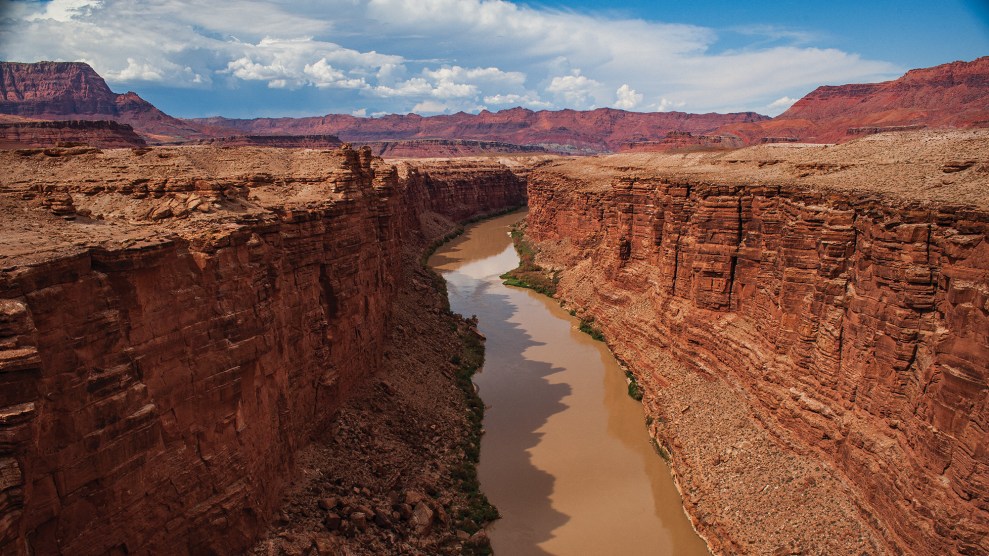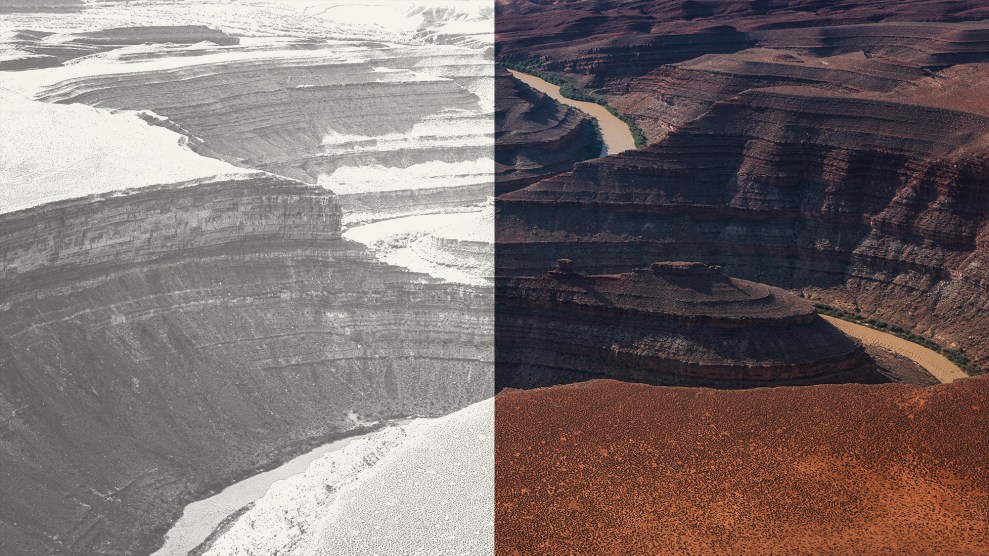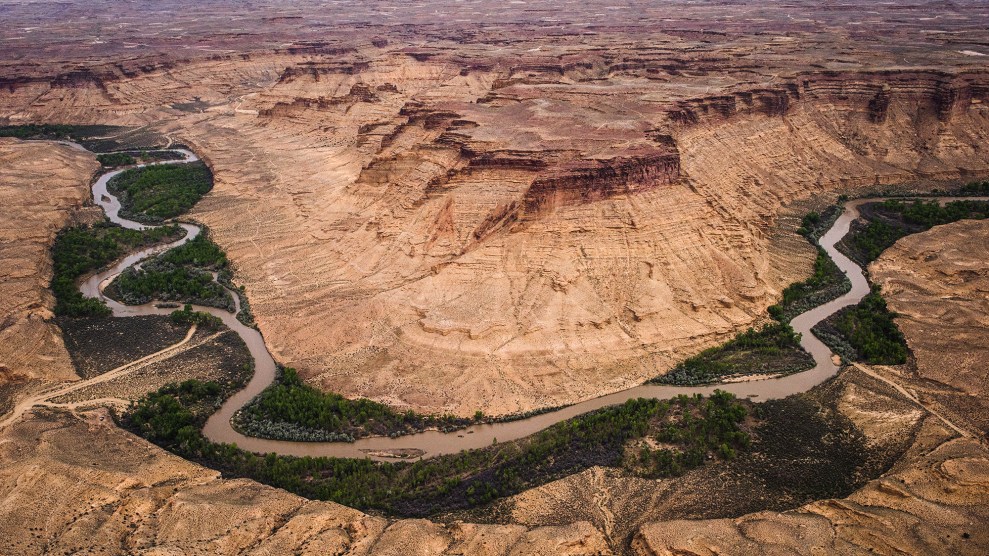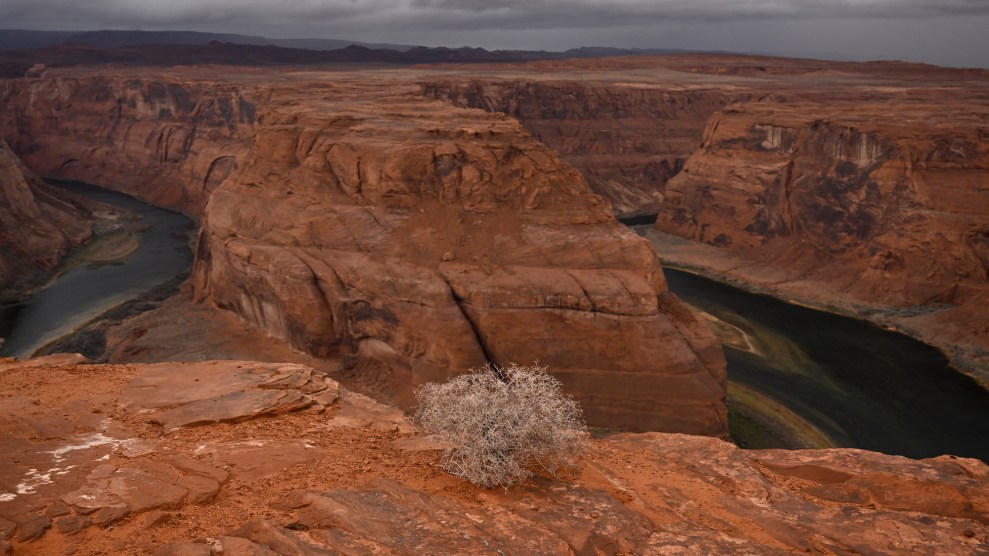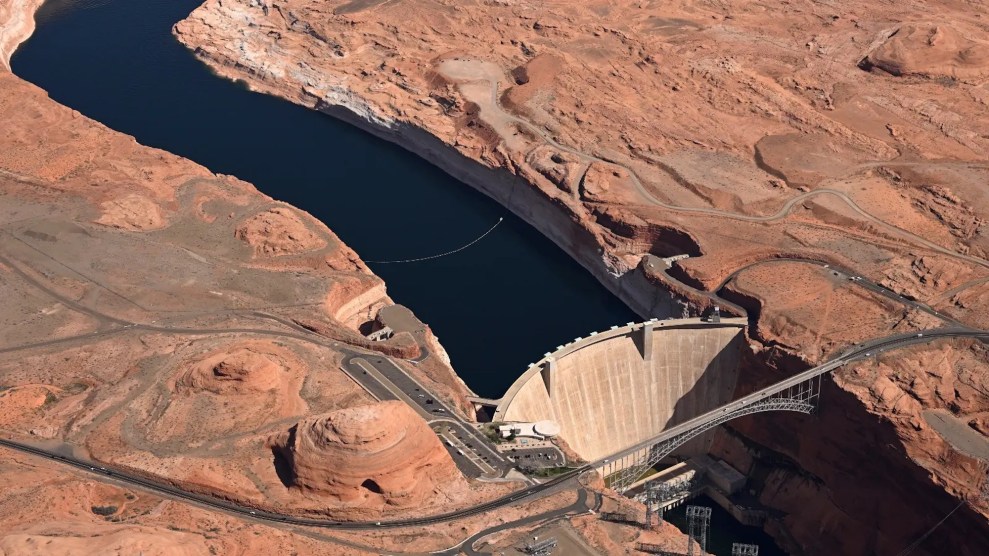
The Colorado RiverRJ Sangosti/MediaNews Group/The Denver Post/Getty/Grist
This story was originally published by Grist and is reproduced here as part of the Climate Desk collaboration.
There are three main forces driving the conflict on the Colorado River. The first is an outdated legal system that guarantees more water to seven Western states—Arizona, California, Colorado, Nevada, New Mexico, Utah, and Wyoming—than is actually available in the river during most years. The second is the exclusion of Native American tribes from this legal system, which has deprived many tribes of water usage for decades. The third is climate change, which is heating up the western United States and diminishing the winter snowfall and rainwater that feed the river.
The states and tribes within the Colorado River basin have been fighting over the waterway for more than a century, but these three forces have come to a head over the past few years. As a severe drought shriveled the 1,450-mile river in 2022, negotiators from the seven states crisscrossed the country haggling over who should have to cut their water usage, and how much. As the arguments dragged on, the Biden administration chastised states for letting the water levels in the river’s two main reservoirs fall to perilous lows. The Navajo Nation, the largest tribe on the river, went before the Supreme Court to argue for more water access.
These issues are all converging ahead of this fall’s presidential election, which could upend negotiations by ushering in a new Congress and new leadership at the federal Bureau of Reclamation, which controls the river. With the clock running out, two major deals are now taking shape. They could fundamentally alter the way states and tribes use the river, bringing about a fairer and more sustainable era on the waterway—if they don’t fall apart by November.
The first deal would see the states of the river’s so-called Lower Basin commit to lowering their water usage by as much as 20 percent even during wetter years, addressing a decades-old water deficit driven by Arizona and California. There are still questions about how much water the states of the Upper Basin, led by Colorado and Utah, will agree to cut, but state leaders expressed optimism that a final agreement between all seven states will come together in the next few months.
“This is not a problem that is caused by one sector, by one state, or by one basin,” said John Entsminger, the lead river negotiator for Nevada, in a press conference announcing the Lower Basin’s plan to cut water usage. “It is a basin-wide problem and requires a basin-wide solution.”
The second deal would deliver enough new river water to the Navajo Nation to supply tens of thousands of homes, ending a decades-long legal fight on a reservation where many residents rely on deliveries of hauled water.
If both of these deals come to fruition, they would represent a sea change in the management of a river that supplies 40 million people with water. But neither one is guaranteed to come together, and the clock is ticking as the election nears.
The last time the seven river states drafted rules for how to deal with droughts and shortages was in 2007, long before the current megadrought reached its peak, and these rules are set to expire at the end of 2026. This deadline has triggered a flurry of talks among state negotiators, who are trying to reach a deal on new drought rules this spring. This would give the Biden administration time to codify the new rules before the presidential election in November, which states fear could tank the negotiations by thrusting a new administration into power.
The furious pace of negotiation is nothing new, but states have until now only managed to agree on short-term rules that protect the river over the next three years. Last summer, the states agreed to slash water usage in farms and suburbs across the Southwest in exchange for more than a billion dollars of compensation from the Inflation Reduction Act passed by Congress. That agreement helped stave off a total collapse of the river system, but it never represented a permanent solution to the river’s water shortage.
As the states turn their attention to a long-term fix, the political coalitions on the river have shifted. The marquee conflict last year was between California and Arizona, the two largest users, who disagreed over how to spread out painful water cuts. California argued that its older, more senior rights to the river meant that Arizona should absorb all the cuts even if it meant drying out areas around Phoenix. Arizona argued in turn that California’s prosperous farmers needed to bear some of the pain. In the end, the money from the Inflation Reduction Act helped paper over those tensions, as did a wetter-than-average winter that restored reservoir levels.
But now California and Arizona are on the same side. The two states, which along with Nevada make up the river’s “Lower Basin,” have pledged to cut water usage by as much as 1.5 million acre-feet even when reservoir levels are high, without federal compensation like that provided by the Inflation Reduction Act. The details still need to be hashed out, but these cuts would likely mean far less cotton and alfalfa farming in the region around Phoenix, tighter water budgets in many Arizona suburbs, and a decline in winter vegetable production in California’s Imperial Valley, an agricultural hub that is considered the nation’s “salad bowl.”
This cut would free up enough water to supply almost 3 million households annually and would address the longstanding issues in the river’s century-old legal framework, which relied on faulty measurements of the river’s flow and thus guaranteed too much total water to the states. Experts have estimated the overdraft to be around 1.5 million acre-feet, the same amount that the Lower Basin is now signaling that it’s willing to give up, even before drought measures kick in.
The harder question is what to do during the driest years. The Lower Basin states are arguing that the seven states of the river should reduce their water usage by almost 3.9 million acre feet during the driest years, equivalent to about a third of the river’s total average flow. The Upper Basin states of Colorado, Utah, Wyoming, and New Mexico have a very different view: in a competing plan also released on Wednesday, they argued that the Lower Basin states should absorb the entirety of that 3.9 million acre-feet cut.
“If we want to protect the system and ensure certainty for the 40 million people who rely on this water source, then we need to address the existing imbalance between supply and demand,” said Becky Mitchell, the lead Colorado River negotiator for the state of Colorado, in a press release following the release of the Upper Basin’s plan. “That means using the best available science to work within reality.”
A representative from Colorado said the Upper Basin would keep investing in voluntary programs that pay farmers to use less water, but insisted that Arizona and California should bear the brunt of drought response.
Disagreement between the two regions is nothing new. The Upper Basin has often argued during past dry spells that, since it’s the Lower Basin that pulls water from Lake Powell and Lake Mead, it’s the Lower Basin that should cut usage when those reservoirs run low.
But the commitment by Arizona and California to slash their water consumption for good even during wet years represents a significant breakthrough from previous talks, according to John Fleck, a professor at the University of New Mexico who has studied the Colorado River for decades. Fleck believes the Upper Basin states should make a voluntary commitment in turn, even though they have never used their full share of the river’s water.
“The idea behind what the Lower Basin is proposing is, ‘We recognize that we have to forever and permanently fix the structural deficit,’” he said. “That’s huge. My concern is that the Upper Basin’s approach to these negotiations is passing up an opportunity for a really useful compromise.”
Entsminger, the Nevada negotiator, conceded that wide gaps remain between the Upper Basin and Lower Basin proposals, but expressed optimism that the states would find an agreement.
“I know the sexy headline is going to be, ‘four versus three, states on the brink,’ but we are at one step in this process,” he said.
The other major water deal coming into focus would also rectify a longstanding issue in the river’s legal framework: its exclusion of Native American tribes. The dozens of tribal nations along the Colorado River have theoretical rights to river water, but they must sue the federal government to realize those rights, under a precedent known as the Winters doctrine. Some of those tribes, like Arizona’s Gila River Indian Community, have settled with the government for huge volumes of water, but others have been tied up in court for years.
The Navajo Nation, whose reservation stretches across much of Arizona and New Mexico, is among the largest tribes with so-called un-settled rights. The tribe has been suing the federal government for decades to obtain rights to the Colorado River as well as other waterways. Last year, the Supreme Court appeared to deal the Nation a serious setback when it ruled that the Biden administration didn’t have an obligation to study the Nation’s potential rights to the Colorado River.
In the aftermath of that Supreme Court defeat, tribal leaders set to work hashing out a landmark settlement that covers not only the Colorado River but also several of its tributaries, working with federal and state governments to resolve decades of litigation across numerous different court cases.
The work has now culminated in a sprawling legal agreement between the Navajo, the neighboring Hopi and San Juan Southern Paiute Tribes, the Biden administration, Arizona, and more than a dozen other water users in the Southwest. The agreement would deliver at least 179,000 acre-feet of fresh water to parts of the reservation that currently rely on depleted aquifers or bottled water deliveries, enough to supply almost half a million average homes annually. This new water would come from entities like the state of Arizona and the Salt River Project water utility, who are voluntarily giving up their water to the Navajo to avoid the threat of further litigation. (The average Navajo Nation household uses around 7 gallons of water per day, less than a 10th of the national average.)
Not only would the settlement revolutionize water access on the Navajo and Hopi reservations, it will also resolve a huge uncertainty for Lower Basin states. A trial victory for the Navajo Nation would likely have slashed Arizona’s water supply, potentially reallocating much of Phoenix’s water system to the tribe.
“Given the background of climate change and the [seven-state] negotiations, just knowing what rights everyone has is really good,” said Heather Tanana, who is Diné and studies tribal water rights as a law professor at the University of Utah. “There’s this certainty now.”
But the success of this deal is far from a foregone conclusion, Tanana added. The settlement needs to be ratified by Congress and signed by the president. Congress must also provide billions of dollars for infrastructure that would pipe water from the Colorado River and its tributaries across the reservation. Tribal leaders are optimistic that the current Congress will support the deal, but they’re anxious that lawmakers won’t push it through before the November election. Past water settlements on the reservation have taken years to secure congressional approval and decades to actually construct.
The outlines of a potential solution are visible in both the interstate negotiations and the Navajo settlement, but both deals are a long way from being finalized. Time is of the essence; many observers are concerned that a second Trump administration would take a more lax approach to water management on the Colorado River than the Biden administration has, and that a shift in the control of Congress could scramble support for the Navajo deal.
The political jockeying of the next few months will go a long way toward determining the river’s future, said Elizabeth Koebele, a professor of political science at the University of Nevada, Reno, who studies water negotiations.
“These decisions now are very consequential for whether we’re going to pivot toward long-term sustainability in the basin,” she said.
